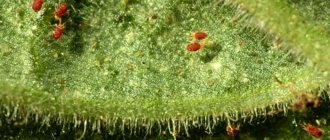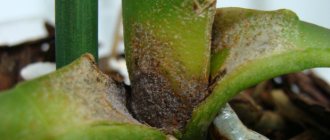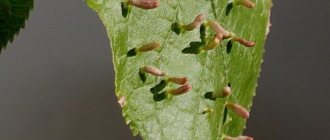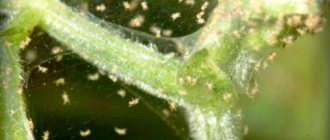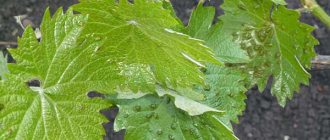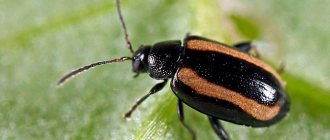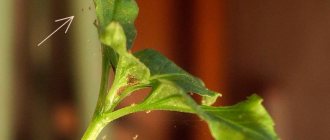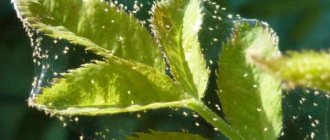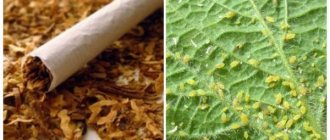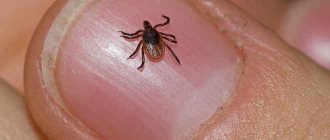Dacha work is always carried out in anticipation of a new harvest of ripe berries, vegetables and fruits. There is nothing more satisfying than picking juicy, fragrant strawberries from your own garden bed. However, sometimes, joy is overshadowed by various plant diseases and insects, which not only feast on the fruits, but can also cause great harm to the entire crop, and even destroy the bushes. One of the most dangerous parasites for strawberries is the spider mite.
How dangerous are spider mites for strawberries?
If the strawberry leaves begin to dry out and curl, inspect them. The presence of a thin web indicates that the plant is affected by spider mites.
The appearance of the pest is very difficult to notice. This small insect settles on the leaves, flowers, berries of strawberries and wild strawberries. In early spring, when the weather is warm +10-12 ⁰C, the pest wakes up from hibernation and crawls from the top layer of soil or unharvested grass to the lower parts of the leaves. The tick feels especially comfortable in hot and dry weather. In such conditions it multiplies very quickly.
If you do not notice the threat in time and allow the pest to multiply widely, you can lose most of the strawberry harvest. And the older the planting, the more damage the parasite will cause not only to this season’s harvest, but also to the next one, since it can disrupt the growth of flower buds. The most defenseless plants against pests are those that have reached 3-4 years of age.
Weevil during flowering
You can protect the future harvest by spraying the plant twice a season: in spring (a week before flowering) and in summer (in July). The following working compositions are used: Fitoverm, Akarin, Iskra-bio.
Sometimes a third treatment is carried out if insects were found in the beds. This can be done with drugs: Anthonem - F, Namabakt.
Among the effective folk methods of fighting the beetle:
- mechanical assembly from bushes;
- planting nearby beds of fragrant herbs (wormwood, tansy, hot pepper);
- treatment with mustard solution (3 liters of water per 100 grams of defect);
- an adhesive mixture based on laundry soap (40 g) and 3 kg of ash.
Causes of ticks
Spider mites can appear on your property for various reasons. Typically, the main sources are people and pets.
Factors contributing to the appearance and reproduction of spider mites:
- planting seedlings infected with pests;
- the spread of insects and their larvae can occur on shoes, clothing and tools; domestic animals are also carriers;
- Planting strawberries too densely helps insects spread faster;
- large growth of mustache;
- neglect of weeding;
- planting too quickly to the previous location of strawberries and nightshades;
- old bushes that have not been updated for a long time.
Irregular feeding weakens the immunity of plants and makes them more vulnerable to diseases and insects.
Tobacco thrips: how to fight it?
If you detect even the slightest symptoms of the presence of strawberry or spider mites on strawberry bushes, you must immediately begin to fight them. Otherwise, your plantation may significantly lose its yield or even die.
The most common control method is to introduce predator mites onto the plantation. This method is applicable at any time of the year. An introduced predatory mite can reduce the number of parasites quite well.
In addition to using predatory mites, there are the following folk methods of control:
After harvesting, it is necessary to cover the beds on which there are infected bushes with plastic film (like a greenhouse). This will prevent warm air from getting inside. When the temperature in the garden reaches 60 degrees, remove the film and cut off the affected plants cleanly (to the very root). After this, the beds should be covered with humus; Onion infusion has proven itself well in the fight against ticks. To prepare this infusion, you need to take about 200 g of regular onion peel and add 10 liters of water. The resulting solution should infuse for 5 days. Then it should be filtered and immediately begin processing the affected bushes. Onion infusion should be used at the very beginning of the growing season. It is also used twice after harvesting from the site.
Please note that after processing the beds must be covered with plastic wrap for several hours
Harmful insects inhabit berry beds not only in open ground, but also in greenhouses. Possessing an excellent appetite, they deal with plants in a matter of days, so you need to start processing without delay.
https://www.youtube.com/watch?v=Sc5R_q2j0w0
If you are having difficulty diagnosing a problem with a plant, you should consult a specialist. This will help you quickly select the right drug and preserve the harvest of delicious berries, and at the same time save the plantation from destruction
After all, if you want to get rid of aphids, ants and other small berry parasites, it is important to water the bushes on time to protect the crop
Tags: fight, tick, strawberry, spiderweb About the author: admin4ik
Signs of a spider mite
Due to the microscopic size of the pest, it is quite difficult to notice in the initial stages. It is necessary to regularly inspect the plantings and treat them with folk or chemical means at the first sign.
Signs of spider mites appearing on strawberries:
- The leaf plates wrinkle and change shape. Over time they turn yellow and fall off.
- The bushes develop poorly and grow smaller in size compared to previous seasons.
- A white film can be found on the bottom of the leaves.
- The leaves lose their color and become covered with yellowish spots. This is due to the fact that the insect feeds on plant sap.
- The fruits become small.
- Plant immunity weakens and they may not survive the winter cold.
- The main sign by which you can accurately identify a spider mite is the appearance on any part of the plant of a rather dense web with small red or brown dots, which are the same insects.
As the season progresses, the insect population increases. It reaches its maximum value from August to September. In October, before the cold weather, the pests move into the soil or hide in thickets of grass or uncollected fallen leaves - there they overwinter safely.
If the infection occurred recently, then the first harvest of berries may be of quite high quality. However, over time, the strawberry bushes will weaken more and more, and may die if no measures are taken.
Biological description of the pest, development cycle
Several closely related species of spider mites can feed on strawberries.
The most common parasites on crops are:
- Strawberry mite, lat. Tetranychus fragariae;
- Garden spider mite, lat. Schizotetranychus pruni;
- Common spider mite, lat. Tetranychus urticae.
You can study the appearance and life cycle of these pests using the example of the common spider mite. Like most pests of closely related species, it is small in size. The length of adults varies from 0.2 to 0.6 mm. The upper part of the body is convex, the lower is flat.
The number of legs is 4 pairs. Each walking limb consists of five segments and ends in a claw. They help the pest not only move, but also stay on the plant.
The mouthparts of spider mites are called chelicerae. They are designed so that the pest can not only pierce the above-ground parts of the plant, but also suck the juice out of them. The fused segments of the chelicerae look like sharp stylets. Sexual dimorphism is clearly visible.
Important! The main difference between females and males is their size. Females are twice as large as males.
Females
The body of the female is wider and longer than that of the male. The color of young individuals is grayish-green. You can see the spots on the sides of the tick. Overwintering females of the pest are colored red or red-orange. There are six transverse rows of bristles on the dorsal part. The genital organ is located on the lower side of the body.
Females have an arachnoid gland. It is located at the second pair of head legs - the pedipalps. With its help, an adhesive thread is produced, which helps the pest move around the plant and holds it on it.
Males
In terms of body size, males are approximately two times smaller than females. Their body length is on average 0.2 mm. The shape is narrower, and at the end of the body there is a copulatory organ. It is needed for fertilization of females.
Lifestyle and development cycle
To successfully combat a pest, you need to know its lifestyle, how it develops and at what stage of its existence it is most vulnerable to drugs.
Long-term observations have shown that adult females hide in plant debris or soil and enter diapause. This occurs from mid-August to mid-September, when the temperature drops to +5 degrees Celsius. In the spring, as soon as the air warms up to + 14, the pest begins to emerge from its shelters. The females begin laying eggs. Spider mites go through four stages:
- Egg. Overwintered females climb the plant and lay eggs on the underside of the leaf blades. They are spherical or oval in shape, translucent, colorless or pale green. The egg size is about 0.14 mm. At a temperature of + 15 degrees, the egg develops in about 12 - 14 days; if the air temperature is + 30 degrees, then the stage is reduced to 3 - 5 days. At this stage the pest does not feed.
- Protonymph or first instar larva. It has a hemispherical body, clearly visible limbs, at this stage there are 6 of them. It actively feeds on the underside of the leaves.
- Deutonymph or second instar larva. At this age, the larvae feed even more actively. They grow in size and have 8 limbs. After a few days they turn into an adult insect.
- Imago. From the first summer clutches, both females and males emerge from the larvae. As soon as with the onset of autumn the temperature begins to drop and daylight hours shorten, then all females and males born in the summer die, only fertilized females go to winter.
Important! Considering the development cycle of the spider mite, we can conclude that the pest causes harm to the plant at all stages, excluding the egg stage.
Ways to control spider mites on strawberries
After discovering a parasite, you need to immediately treat all strawberry bushes in order to save the infected ones and prevent the insects from spreading to other plantings on your site.
There are two main ways to deal with spider mites:
- chemical (insecticides);
- natural folk remedies.
Insecticides
Chemical preparations are the most effective in combating various plant diseases: Neoron, Marolex, Actellik, Karbofos, etc. They show good results in killing insects.
The most popular drug against spider mites is Karbofos. The dilution proportions of the product are indicated on the packaging.
Rules of use:
- The treatment should be carried out in the morning or evening;
- for the best effect of the drug, it should be sprayed in dry, windless weather;
- the air temperature must be at least +18 ⁰С;
- treatment can be carried out before flowering and after harvesting;
- spray not only the upper part of the bushes, but also the underside of the leaves.
Important! Despite the fact that Karbofos has a moderate level of toxicity, precautions should be taken during processing: protect the skin and respiratory tract, do not spray near pets or in gusty winds.
Traditional methods
There are also safer and more environmentally friendly methods for getting rid of spider mites on strawberries.
Biological method . Release of insect predators onto the site. These include mites: Amblyseius and Phytoseiulus. You can buy them at garden stores.
The predator begins to be active at +18 ⁰C and can withstand quite high temperatures. It also needs high humidity - from 70%.
These insects can destroy up to 95% of the spider mite population. And after the work is done, the individuals die.
Infusion of onion peels or garlic / To prepare, you need to take dry onion peels (chopped garlic), soak in water for several days. The infusion is filtered and the strawberry bushes are treated with it from the top and bottom sides. After spraying, you need to cover the beds with plastic wrap for a day.
Important! This method will help with a small number of pests. If there is an infestation of insects, it is better to use chemicals.
Plants that protect against pests
According to some gardeners, if you plant plants such as tansy, catnip, lavender, rosemary, chamomile between rows of strawberry beds, they will repel insects with their specific smell.
Why sanitation first?
The mite, although very small, gradually affects the entire strawberry bush.
- Having transformed into a brown outfit, ticks go to winter, under strawberry leaves, in weeds, and in piles of leaves that have fallen from trees.
- Hiding under a strawberry leaf, the tick spends the winter well.
It’s a completely different matter when autumn harvesting of a strawberry plantation is carried out. If you do this correctly, then you need to mow down the old foliage, remove everything from the garden bed, leaving only the rhizomes .
Rules for mowing leaves
Sometimes gardeners are too zealous and mow down the leaves immediately after fruiting, without understanding the purpose. This should not be done.
It is better to cut off strawberry foliage just before frost, so that repeat leaves do not appear this year.
During the process of photosynthesis, nutrients are formed in the leaf blades and transferred to all parts of the plant. By removing a leaf too early, in an effort to keep it clean, we weaken the plant. The leaf grows new, young, and goes away before winter, but, however, still provides shelter for ticks.
But mowing the foliage just before frost, thoroughly removing it from the site, with loosening and digging up row spacings significantly reduces the population . Some of the mites still remain at the base of the bushes, but by treating the strawberries with an acaricidal preparation, we can easily deprive them of the opportunity to survive.
Prevention
To avoid having to fight pests and worry about the strawberry harvest, carry out regular preventive maintenance:
- In the spring, after the snow has melted, water the beds with hot water (60 ⁰C).
- When purchasing, pay attention to the condition of the seedlings. The bushes must be healthy, without any damage.
- Do not allow the soil under the strawberries to dry out. Mulching will help maintain suitable humidity at all times.
- Fertilize your plants. Fertilizing strengthens the immune system, making strawberries better resistant to diseases.
- Remove excess tendrils, weeds and fallen leaves. It is in them that spider mites overwinter.
- Replant strawberries to a new location every 4-5 years.
- In the fall, you can spray the bushes with insecticides for prevention.
How to kill ants in berries?
Red ants love dense places and wet beds, so they often settle directly in strawberries, damaging the crop. The greenery remains intact and unharmed. Tilling the soil in the root zone will help cope with insects. A variety of means are used for these purposes:
- based on ammonia (50 ml of alcohol per 10 liters of water, consumption per bush is 500 ml);
- tinctures of wormwood and tansy.
You can also make a powder from a mixture of copper sulfate and quicklime. An alternative is to place sprigs of fragrant herbs (mint, wormwood, etc.) under the bushes.
It is effective and safe to place yeast and sugar traps in garden beds to collect insects and carry them outside the garden. It is also appropriate to dig up ant nests to remove eggs and then transfer them beyond the boundaries of the site.
The three-millimeter bug poses a danger to strawberry crops. Insects colonize plants en masse, intensively eating foliage, buds, and shoots. Moreover, the age of the strawberry does not play any role, everything is used.
The first signs are:
- dried damaged leaves, buds;
- deformed underdeveloped fruits.
Spider mite-resistant strawberry varieties
Selection does not stand still. And strawberry varieties that have high immunity to pests regularly appear on sale.
Varieties less susceptible to various diseases:
- Torpedo;
- Knight;
- First grader;
- Cinderella of Kuban;
- Sunrise;
- Purple;
- Anastasia;
- Sunny meadow;
- Kokinskaya dawn.
Spider mites are a common and dangerous disease of strawberries. To protect plants and get a good harvest, follow agricultural practices, carry out preventive maintenance and constantly monitor the condition of the plantings.
Harm
Spider mites harm strawberries by sucking plant juice and disrupting the development of vegetative and generative organs. With massive damage, the leaves dry out. The process of photosynthesis decreases and the nutrition of the entire plant deteriorates.
The pest can damage buds and flowers. If you do not take active control measures, then ripened berries lose their presentation and taste.
Female spider mites are quite fertile and can lay an average of 100 - 150 eggs in 20 days of their life. In the open ground of a temperate climate, 2–3 generations of the pest can be observed per season.
Slugs
Unpleasant sticky parasites willingly settle in beds where there is high humidity, since water is considered an integral part of their life. The pest eats mainly berries, so if an invasion occurs without a quick response, you can say goodbye to the harvest.
For prevention purposes, it is worth irrigating taking into account the degree of soil moisture, clearing the beds of weeds, and mulching the soil. If a family of slugs is detected, the area must be treated with the following drugs: Slimax, Metaldehyde.
Slugs
Feedback from agronomists
Korsunov I.I., 49 years old, Stavropol Ticks are dangerous because they can hide deep in the leaves of the rosette. If the treatment procedure is not carried out carefully enough, the likelihood of pest reappearance may increase.
Larin O.P., 43 years old, Nizhny Novgorod I do not support the use of insecticides to protect berry plants. Although in a minimal amount, the poison can get into the tissues of plants and fruits, and this is the cause of a threat to life. I recommend everyone to use biological products and home remedies (while there are few arthropods).
Strawberry nematode
A nematode is a round, small worm with an elongated, cylindrical shape.
Pests can spread not only to strawberries, but also damage all vegetable plants.
In most cases, the nematode settles in the buds, leaf axils, and buds of the plant. The result of this finding is damaged ovaries and deformed buds. The plant is severely damaged and does not produce berries.
Like many types of strawberry pests, nematodes can persist in the surface layer of soil for a long time.

